THE JOYS OF JANUARY
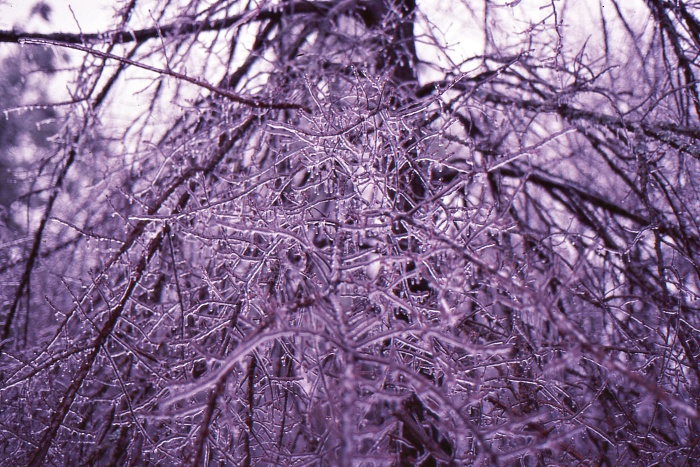
This newsletter is being completed in the aftermath of an ice storm accompanied by a bit of snow, but the main impact was the better part of an inch of freezing rain. I enjoy snow but sleet and rain that turns to ice as soon as it touches ground is another story. Maybe it’s just a faulty memory, but it seems to me that my boyhood had a lot more snow and a lot less ice than is the case today.
Whatever the case, in long ago yesteryears, for me January was a month filled with joy. An integral and important part of those carefree days of boyhood adventure focused on food. I hunted for food, mainly rabbits at this time of the year, but outdoor activity also meant consuming a lot of grub. Like most active teenagers, I was a trencherman of no mean ability, and my trusty Duxbak jacket, whatever it carried at day’s end, always held plenty of food at the start of a rabbit hunt. Sandwiches featuring whatever was available—fried streaked meat, leftover chicken, meatloaf, country ham, fried eggs and baloney, peanut butter and jelly—were standard. So was a tin of Vienna sausages or sardines, with a sleeve of soda crackers as an accompaniment. Often there would be a chunk of cornbread, and a small raw onion, boiled egg, or turnip went just fine with it. Another favorite was a cold sweet potato. Add a couple of apples from Dad’s small orchard, still crisp and sweet thanks to cool storage in the basement; maybe an orange from Christmas; some Chinese chestnuts from our tree; and all that remained necessary to ward off any hints of peckishness were treats for the sweet tooth—and did I ever have one (still do, for that matter).
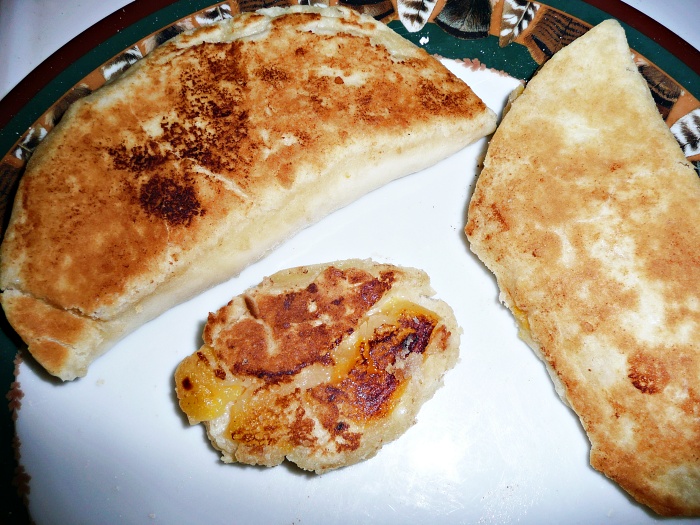
My two favorites in that regard, and it would have been a tossup as to which I preferred, were homemade fried pies and hefty slices of Mom’s apple sauce cake. Usually one or the other was available, at least early in January when the blessings of Christmas bounty had not been exhausted. Fruit cake was another choice, because invariably Daddy had one or two given to him each year. Throw in assorted cookies (especially those made with walnuts), hard candy, leftover holiday gum drops and orange slices, and I had all that a greedy-gut boy could want for a field lunch or a mid-afternoon sugar boost. Occasionally I would carry a thermos of milk or hot chocolate, but more often I just drank from a spring or branch. Both were available pretty much everywhere you turned in the Smokies, and in those days I didn’t even know what giardia was, much less worry about it. The water was so cold it set your teeth on edge, slightly sweet, and pure as driven snow.
Another standard January activity, one I look back on with great fondness, involved listening to the radio on Saturday and Sunday evenings. We didn’t have a television (almost certainly that was a blessing), but the entire family would listen to some of the popular radio shows of the day. I particularly remember “Amos and Andy” (which would never pass political correctness muster in today’s world), “Gunsmoke,” “Gene Autry,” the “Grand Old Opry,” and the Wayne Raney Show on WCKY out of Cincinnati with its brand statement, “50,000 watts of pure power.” We also listened faithfully to North Carolina basketball in the glory days of Lenny Rosenbluth and, a few years later, Billy Cunningham, known as the Kangaroo Kid because of his leaping ability.
More often than not, while we listened to the radio there would also be an intense session of picking walnut meats. The nuts would have been gathered back in late October or November, allowed to dry and cure so that husks could be easily removed, and at some point Daddy would spend a few hours cracking them atop an anvil. Everyone would pitch in to dig out the meats, and as anyone who has ever dealt with walnuts knows, it is a chore requiring patience and care. In the end though, the rewards were well worth it. Mom used the nuts in all sorts of baking. Her chocolate chip-and-walnut or oatmeal-walnut cookies, when still warm from the oven and served with a tall glass of milk, were pure Nirvana. The nuts also went into her version of Waldorf salad, applesauce and orange slice cakes, banana nut bread, walnut bars, and a host of other treats.
Beyond that, January brought all sorts of joy. I recently put together a short listing of those delights for the individual responsible for seeing that this newsletter gets to you in good order each month, Tipper Pressley (any delays are invariably due to my laggardliness and not her fault). She was under the weather for a bit and I was trying to help a tad by writing a guest post for her daily blog, “Blind Pig & the Acorn” (incidentally, if you aren’t a subscriber, I highly recommend it to anyone who loves Appalachian traditions). It involved “January Jubilation,” and I thought I’d share those thoughts. Here they are:
Fond thoughts of Januaries in yesteryear run through my mind like the soothing sound of a gurgling mountain branch or the visual delight of a land bedecked with freshly fallen snow. By February winter would have become somewhat tiresome, producing mollygrubs or cabin fever, but the year’s first month somehow had a delightful distinctiveness to it. Here are some of the things I recall about January from a Smoky mountain boyhood filled with magic and mystique.
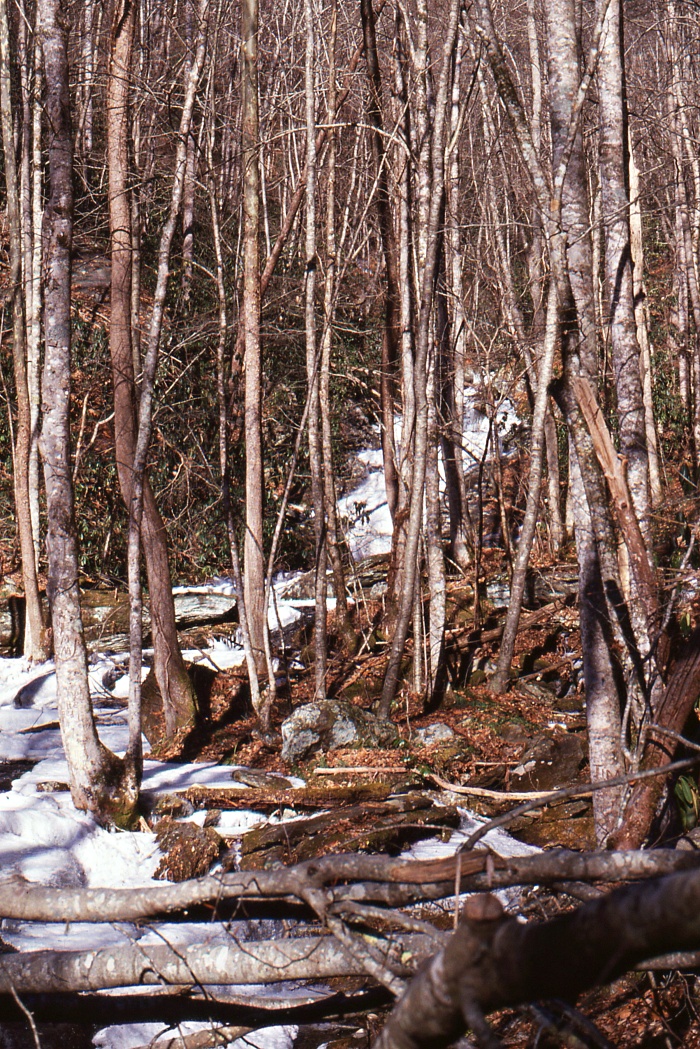
*January was the joy of a snow heavy enough for schools to close, and when that happened there would be snow cream and sledding, construction of snow men and snowball fights, or scrumptious tummy warmers such as hot chocolate or Russian tea when you came indoors. Old timers would talk about how welcome the “poor man’s fertilizer” was and indulge on fireside prognostication about snows still to come.
Those homespun weather wizards relied heavily on signs—things such as “chimney smoke hugging the ground, waiting for more snow to come around” or sun dogs in the afternoon after skies had cleared—as harbingers of what was to come.
*January invariably brought one or two snaps of bitter cold, with rhododendron leaves curled up tight as a Cuban cigar and icicles decorating every seep spring and low-lying streamside bush.
*The month meant mighty fine eating—cracklin’ cornbread and soup beans, pot likker and baked sweet taters, cathead biscuits and smokehouse ham, fried apple pies and fruit sauce for the sweet tooth. It was a fine time to look back with fondness on the hard work that produced winter fare.
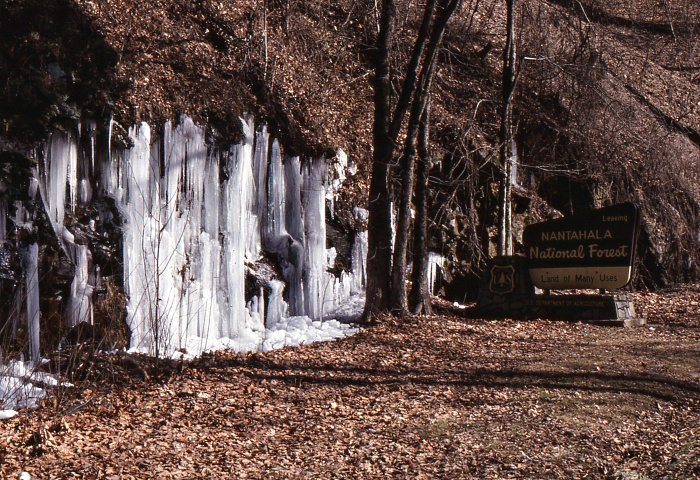
*January was howling winds and hoarfrost, rime ice and freezing rain. It was bitterly cold mornings with frost so heavy that, as a friend, Ken Roper, once put it, “you could track a rabbit.”
*The month was a mountain lad checking his steel traps for muskrats, ‘coons, ‘possums, and maybe the occasional mink. It was that same irrepressible youngster making a circuit of his rabbit gums to see if they had trapped a cottontail or two.
*January was the hallelujah chorus of a pack of beagles hot on the cottontail trail; the unforgettable image of a fine pointer staunch against the skyline as it locked tight on a covey of quail or a grouse (which mountain folks often called pheasants).
*The month was the warming solace of a cheery fire, with family and friends gathered round for a session of walnut picking, quilting, or maybe just pleasant conversation.
*It was the singular treat offered by a baked hen who found her way to the Sunday dinner table thanks to having come up woefully short in her egg-laying duties, and if you were passing lucky, you might get a go at the little rows of eggs in the making lining the inside of the carcass. That was a treat, one fulfilling the words of the grand Bobby Bare song, “Chicken Every Sunday, Lord,” and about the only foodstuff as treasured was a stack cake made using locally produced molasses and apples dried the previous fall.
*It was a month for new beginnings, for sessions of what my Grandpa Joe called “dreaming and scheming,” for putting functional Christmas gifts (Duxbak clothing, new long handles, a boy’s first gun, a new knife or hatchet) to the test of practicality.
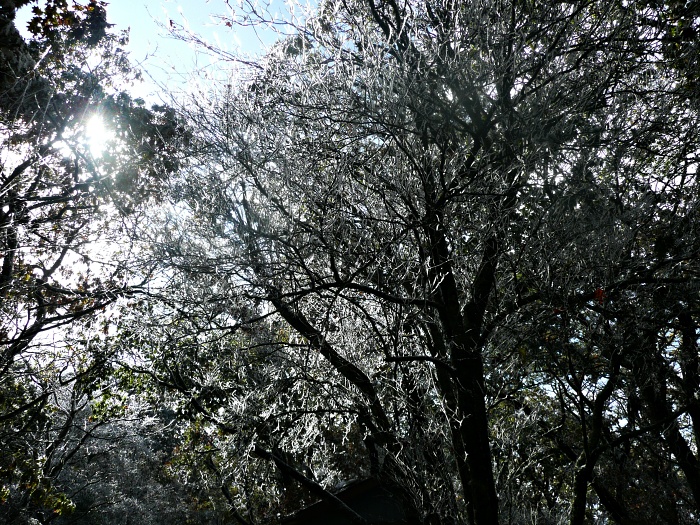
Those long ago Januaries were a time filled with simpler days with simpler ways, and for my part I miss them a great deal. Still, I have the undeniable benefit of being able to look back with longing and dig through memory’s fond vaults for the abundant times of jubilation January could produce. If you are blessed to share some similar things to recall and have known such experiences, tell yourself you’ve been mighty fortunate. For that means, deep in the echoing sound chamber of your mind, that January is calling you home as you harken back to the enduring, endearing richness of Appalachia.
JIM’S DOIN’S
The University of Georgia Press is moving right along with the pre-publication work related to my forthcoming book with them, Fishing for Chickens: A Smokies Food Memoir, and some of the recipes below will appear in its pages. I received the page proofs shortly after Christmas for purposes of a final editing “look-see” and the arduous but important task of indexing (in this case, two indices, one a general one and the second dealing with food and recipes). They’ve got the book pictured and advertised on their website (www.ugapress.org) along with a bunch of pre-publication reviews. I’ve already shared several of these, but there’s an added one from renowned culinary expert Ronni Lundy, James Beard award winning author of Victuals and other books, and I’m flattered by what she says: “Fishing for Chickens sagely, entertainingly, and deliciously reveals that our region is far broader and much more diverse in its stories and experiences than we have yet recorded. By delving deeply into a specific region and using compelling personal narrative and detail, he gives a rich picture that expands, and occasionally challenges, what we think we know about this much storied part of the southern mountains. With a voice inflected with expressions, words, and cadences that are regionally specific, Casada writes with an intimate, conversational feeling that makes this book a pleasure to read.”
The proofreading and indexing have consumed a lot of my time, but as always there are story deadlines to meet. Also, as usual, I’ve got a few things that have appeared in print since the last offering of this newsletter. “The Lunatic Express,” in Chuck Wechsler (Editor), Monsters, Mayhem and Miracles, pp. 119-28, is a story I wrote decades ago about the man-eating lions of Tsavo. You can get the book that reprints this tale, along with dozens of other grand adventures, from the Sporting Classics Store. My heartfelt piece on what Yuletide meant to my mother, “Momma Casada and the Spirit of Christmas,” can be found in “Sporting Classics Daily,” Dec. 12, 2021. That is an on-line publication, and other pieces in the same format are “Mountain Soul Food: Scrumptious Stews,” in the on-line version of Smoky Mountain Living magazine, Dec. 13, 2021 and “Triumph and Tragedy: Building Fontana Dam,” from the same publication, Jan. 12, 2022. Still on-line, I did a guest piece for the webmaster who makes this newsletter possible on her “Blind Pig & the Acorn,” “January Jubilation: Fond Memories of the Year’s First Month,” Jan. 11, 2022″ It was to lift a tiny bit of her work burden as she struggles to get back to full normal after a bout of coronavirus. Recent printed work includes “Unwelcome Neighbors: Coping with Coyotes,” Carolina Mountain Life, Winter, 2021-22, pp. 68-69; “Cooking Wild,” South Carolina Wildlife, Jan./Feb., 2022, pp. 40-45; “The Wonders of Late Winter: A Poetic Walk,” Columbia Metropolitan, Jan./Feb., 2022, pp. 34-42, and “The Literary Saga of a Fallen Giant” (American chestnut), Sporting Classics, Jan./Feb., 2022, pp. 51-53.
RECENT READING
As is normally the case, I’ve been reading in a bunch of genres. Among recent works I’ve enjoyed are John Boles; Jefferson: Architect of American Liberty, a bunch of the fur trade/Indian wars/mountain men novels of Terry Johnson; and several books on Winston Churchill including Geoffrey Wheatcroft’s Churchill’s Shadow (shamefully negative, in my view), Mary Lovell’s The Churchills in Love and War, and Andrew Roberts’s Churchill: Walking with Destiny (probably the best single-volume biography). I consider Jefferson the greatest intellect this country has produced and Churchill the greatest man of the 20th century.
RECIPES
TRADITIONAL MOUNTAIN CORNBREAD WITH CRACKLINGS
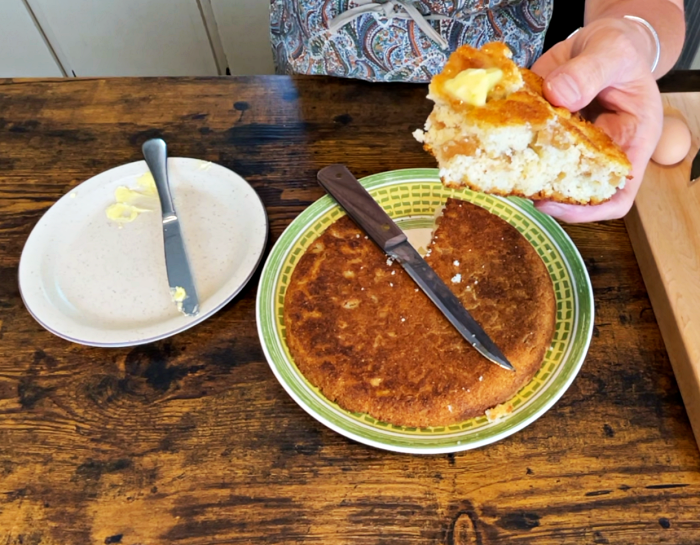
The keys to making really good cornbread are: (1) Cook it in a well-seasoned cast iron skillet, (2) Grease the skillet with streaked meat or bacon, (3) Use stone-ground cornmeal, and (4) Include the right ingredients. Most store-bought cornmeal has been ground at too high a temperature and this does something to the flavor. Often it also contains additives, such as salt or preservatives, which mitigate again a true traditional pone. Also, stone-ground cornmeal, even if it is sifted, has more body or “crunch” to it than other grocery shelf offerings. Buttermilk, eggs, and lard are essential if you want really moist cornbread. This simple recipe has served my family well for as far back as my memory stretches, and I know Grandma Minnie was preparing it this way, though she never measured anything, before the turn of the twentieth century.
2 cups slow-ground cornmeal (white or yellow corn, although I think the best meal comes from a white
field corn such as Hickory King)
1 cup buttermilk
½ teaspoon baking soda
1 skimpy teaspoon salt
1 beaten egg
3 tablespoons grease from streaked meat or bacon (if you want really moist cornbread, add a fourth tablespoon or a heaping one of mayonnaise)
1 pint of cracklings (use a rolling pin to crush the cracklin’s into small bits). Heat the cracklin’s in a frying pan and then stir them into the batter, which should be fairly stiff. Shape into small cakes or bake the entire batch of batter in a well-greased pan.
Prepare skillet in advance (using the streaked meat you cook to get grease). Mix the buttermilk, salt, baking soda and egg with cornmeal and stir thoroughly. Pour grease into the batter and stir in well. Pour batter into pre-heated skillet and bake at 425 degrees for a half hour or until the top crust is golden brown. The bottom crust should be dark brown and the whole pone perfect for slicing or crumbling pieces up in a bowl of pot likker. You can sop with cornbread if you wish, but for the ideal marriage of pot likker and cornpone, a big soup bowl is the way to go.
TIP: Heat the cracklin’s in the pan you plan to use to bake the bread. They will ensure it is nicely greased. Cook at 375 degrees until golden brown.
AFTER THE FEAST SOUP
1 baked hen carcass with some saved chicken scraps (or a wild turkey carcass)
1 large onion, peeled and quartered
4 ribs celery with leaves, chopped
1 large carrot, scrubbed and cut into chunks
2 whole cloves garlic
1 bay leaf
Water to cover
Remove any remaining skin from the carcass. Place in a stock pot and surround with onion, celery, carrot, garlic and bay leaf. Cover with water and bring to a boil. Reduce heat and simmer, covered, for two hours. Refrigerate stock and fat which accumulates on the top. Remove all meat from bones and save.
8 cups stock (add canned chicken broth if needed)
2 cups milk
4 medium potatoes, peeled and diced
3 carrots, peeled and diced
3 ribs celery, diced
1 cup frozen or canned lima beans
2 ounces small shell pasta
2 cups fresh, chopped spinach
1 cup frozen green peas
Meat from carcass
¼ cup fresh parsley
½ teaspoon dried basil
1 teaspoon fresh black pepper
Salt to taste
1 cup evaporated milk
2 tablespoons flour mixed with 4 tablespoons water (optional)
Cook stock, milk, potatoes, carrots and celery for a half hour. Add lima beans, pasta, spinach, peas, chicken meat, parsley, basil and pepper to the soup and cook an additional twenty minutes. Remove from heat, season with salt if necessary, and stir in evaporated milk. Return to low heat, stirring often. Do not let soup boil. Thicken with flour/water paste or cornstarch if desired.
Makes twelve hearty servings
BLACK WALNUT BARS
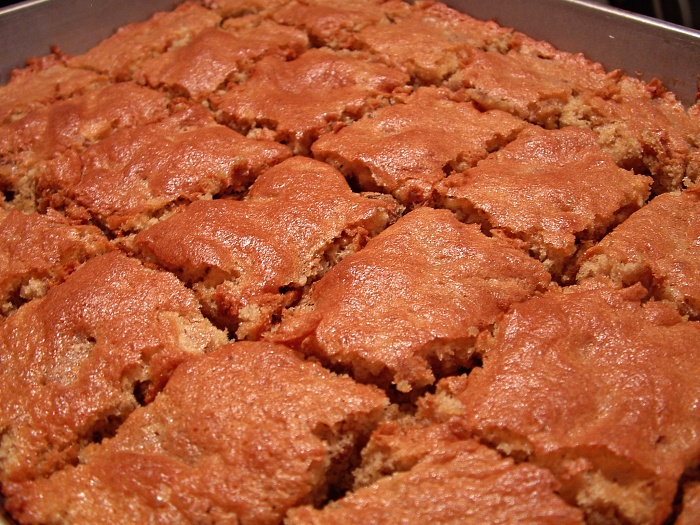
Throughout the Christmas season there would be, in addition to cakes aplenty, various types of cookies at our house and that of my grandparents. Stored in round tins which had once held things like commercial fruit cakes (for years, during a time when one of Daddy’s responsibilities at the furniture plant where he worked was serving as purchasing agent, he received one or more of them every Christmas, and far be it from my frugal mother to let a perfectly good container go to waste), they were available for a quick snack most any time. At this season of the year I don’t even recall the normal strictures such as “you’ll ruin your appetite.” As was true of about anything containing black walnuts, I loved these bars.
CRUST
½ cup butter
½ cup packed brown sugar
1 cup flour
FILLING
1 cup brown sugar
2 eggs, beaten
¼ teaspoon salt
1 teaspoon vanilla
2 teaspoons flour
½ teaspoon baking powder
1½ cups shredded coconut
1 cup chopped black walnuts
Cream butter and brown sugar. Slowly add flour and mix until crumbly. Pat into a 7 x 11-inch baking dish. Bake for eight to ten minutes at 350 degrees until golden.
Combine brown sugar, eggs, salt and vanilla. In separate bowl, add flour and baking powder to coconut and walnuts. Blend into egg mixture and pour over baked crust. Return to oven and bake for an additional fifteen to twenty minutes or until done. Cut into bars and place on wire racks to cool.
RUSSIAN TEA
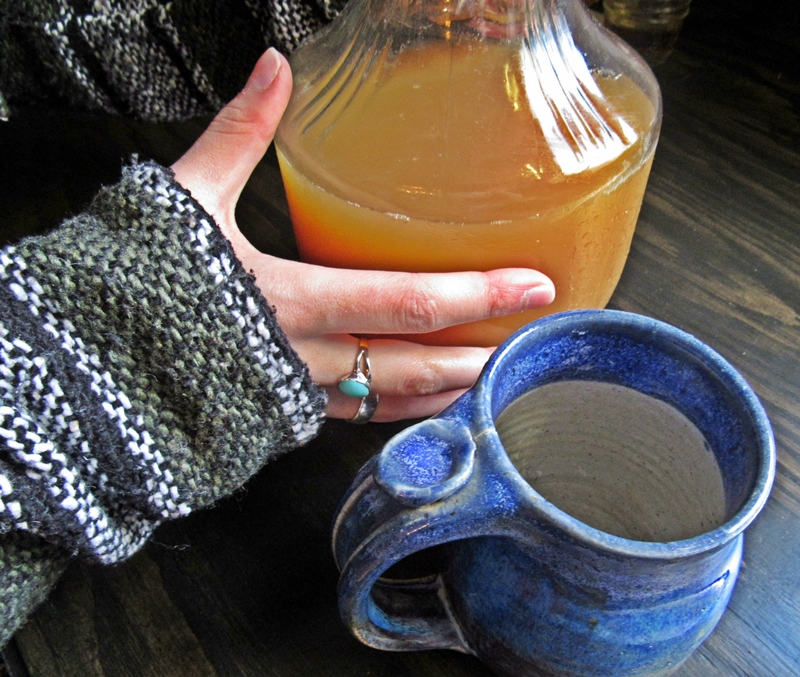
Momma always made a big batch, or maybe two or three of them, of this seasonal delight. The beverage was served at family gatherings, to visitors who just happened to drop by, at church functions, and as a refreshing hot drink on a cold winter’s day. Grandpa Joe loved the drink, which he called “Rooshian” tea (and I guarantee he had no idea whatsoever of the geographical connection or, for that matter, that Russia was a country or where it might be situated in the wider world). He would take a lip-scorching hot cup, “sasser and blow” it to cool it down a bit, and then slurp the drink with ample evidence of having been transported into a realm of pure bliss.
½ teaspoon cloves
1 cup sugar
½ teaspoon cinnamon
1 gallon water
1 tall can orange juice concentrate
Extra sugar if desired
Bring these ingredients to a boil and continue for five minutes. Then add:
4 tea bags steeped in a pint of boiling water for five minutes.
¾ cup fresh lemon juice
1 tall can pineapple juice
1 quarter apple cider (optional)
1½ cup fresh orange juice
The quantities of juice can be varied if you prefer one taste to another. This recipe will make twenty generous helpings, and leftovers can be refrigerated and reheated as desired.